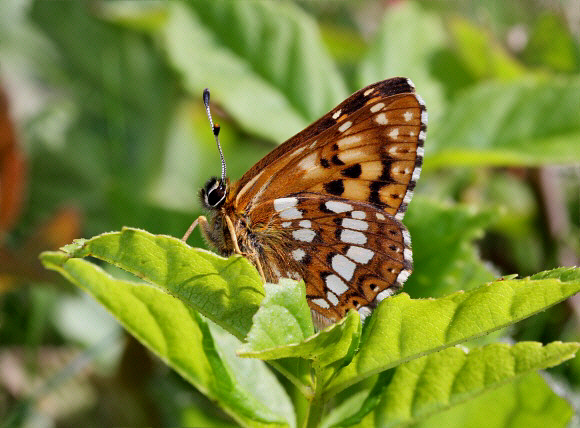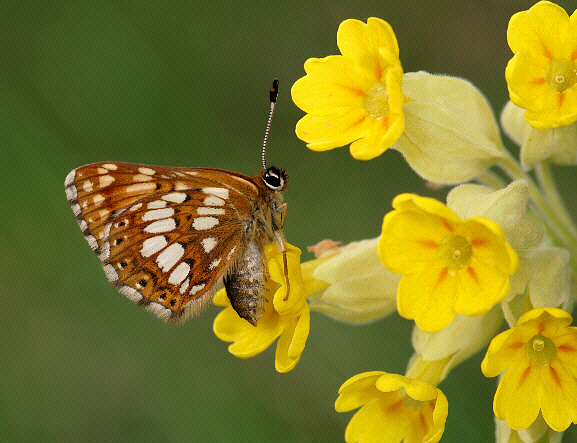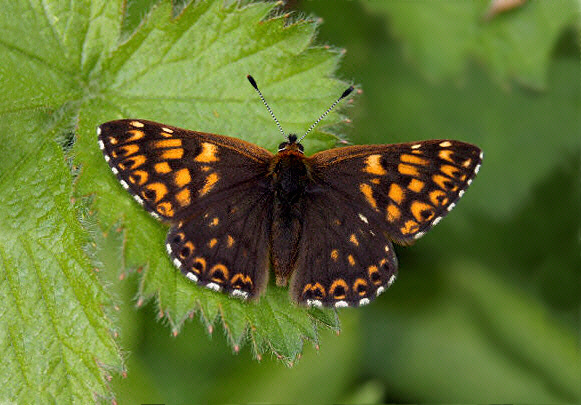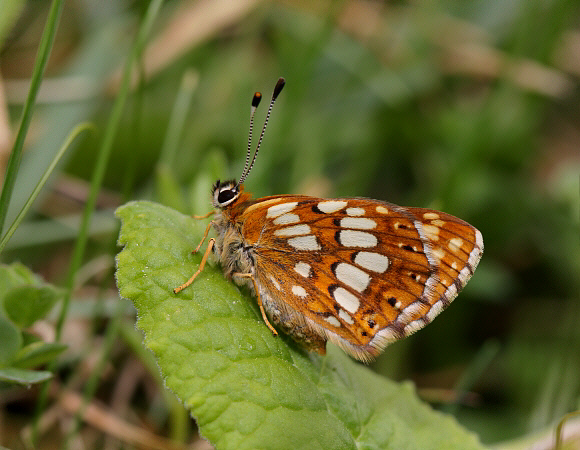 Duke of Burgundy Hamearis lucina, male, Cerne Abbas, Dorset – Adrian Hoskins
Duke of Burgundy Hamearis lucina, male, Cerne Abbas, Dorset – Adrian Hoskins
Introduction
This attractive species is the sole European representative of the Riodinidae, an incredibly varied and fascinating family of butterflies, commonly known as metalmarks, which has it’s headquarters in the rainforests and cloudforests of South America.
The butterfly was originally known as ‘Mr Vernon’s Small Fritillary’ and then the ‘Duke of Burgundy Fritillary’. It is however unrelated to the true Fritillaries which belong to the family Nymphalidae, so the latter part of the name has now been dropped to become simply the Duke of Burgundy.
The Duke of Burgundy is found in scattered colonies across much of Europe, although it is absent from Scotland, Ireland, southern Spain, Portugal, the Mediterranean islands, Norway, Finland and northern Sweden. Beyond Europe it occurs in temperate Asia as far east as the Ural mountains.
Males are noticeably darker than females. They also have thinner abdomens, with the anal claspers clearly visible, and their forewings have a much straighter outer margin. The easiest way to tell the sexes apart however is to count the legs – females have six legs ( the front pair are very reduced in size ), but males have only four.
 Duke of Burgundy Hamearis lucina, female, Hampshire – Adrian Hoskins
Duke of Burgundy Hamearis lucina, female, Hampshire – Adrian Hoskins
Habitats
The Duke of Burgundy was once widespread across much of England and Wales, but it’s range has contracted considerably. There are now only a few dozen colonies, most of which are scattered across central southern England, plus a handful of relict colonies in south Cumbria and east Yorkshire.
It was formerly considered to be primarily a woodland insect, and is still found in a few oak / hazel woods where there is a long unbroken history of coppicing. The abandonment of coppicing at most other woods however has caused the extinction of most colonies.
Historically colonies on scrubby and sheltered calcareous grassland were always scarcer, but it is here that most colonies are nowadays found. Typical sites include abandoned chalk or limestone quarries, disused railway cuttings and scrubby grassland coombes in the south of Britain; and grassland / woodland mosaics on limestone in the north. Most colonies are very small, containing less than 20 adults at the peak of the flight season, but a few substantially larger colonies exist.
 Duke of Burgundy Hamearis lucina, female, Hampshire � Adrian Hoskins
Duke of Burgundy Hamearis lucina, female, Hampshire � Adrian Hoskins
Lifecycle
The Duke of Burgundy emerges in late April on grassland sites, or in early May at woodland sites in southern England, and is single-brooded. Northern populations emerge later, in mid-late May. In warmer parts of Europe, there may be a partial second brood which emerges in August. In England it is extremely unusual for there to be a second brood – the only example I have encountered being a male seen in Hampshire on 5th August 2007, although there were also reports of 3 males seen at Rodborough Common in Gloucester in August 2009.
The spherical, cream coloured eggs are laid in little groups of 3 or 4 on the underside of leaves of the foodplants, close to the edge of the leaf. Females nearly always lay on lush plants growing in dappled sunlight, where the leaves are erect and supported by surrounding vegetation. Usually the chosen plants are growing close to bushes, where they escape grazing by rabbits or sheep.
In coppiced woodlands the eggs are laid on primrose leaves Primula vulgaris, whilst at grassland sites cowslip Primula veris is used instead. Sometimes eggs are laid on nearby plants, rather than directly on the foodplants, e.g. in 2006 I observed a female laying on Potentilla in a Hampshire copse, although there were cowslips and primroses nearby. In April 2007 I observed a female lay 2 eggs on a cowslip flower head, but this is extremely unusual.
The hairy greyish-brown caterpillar feeds nocturnally on the leaves of cowslip or primrose, leaving characteristic nibbled holes. During the daytime it retreats to hide at the base of the plant. It is fully grown in late July, at which time it wanders a short distance to pupate amongst leaf litter around the base of bushes.
The pupa is cream coloured with black spots on the thorax and abdomen, and is usually attached to the upperside of a curled up dead leaf, or to the base of a dead stem.
Adult behaviour
The butterflies are most active on sunny mornings. By about midday activity has usually ceased, although they will fly until mid afternoon in cooler or overcast weather. Duke of Burgundies rarely move far from the immediate vicinity of their breeding sites, but in May 2008 I discovered a fresh male that had wandered from it’s woodland habitat onto a chalk grassland ridge over a mile away.

Duke of Burgundy Hamearis lucina, male, Hampshire – Adrian Hoskins
Males divide their time fairly equally between basking, flying and perching on bushes – typically selecting hazel, dog rose or hawthorn bushes. At woodland sites these perches are usually located at ride intersections or at the edge of small sheltered clearings, where the outlooks maximise their chances of intercepting females. The perches are defended vigorously against other intruding males. When the owner of a perch spots another male he instantly flies up to intercept it, and the pair spiral rapidly upwards together until the intruder gives up and flies away. When females are intercepted copulation follows almost immediately. Mated pairs can sometimes be found in mid-late morning, sitting on bushes.
Females are seen less often than males due to their more elusive and sedentary behaviour. They can sometimes be seen basking on the ground on hazy days, but are most often seen investigating cowslips in small glades.
Both sexes normally bask with the wings half or three-quarters open, often settling amongst short grass growing in sheltered pockets of scrubby grassland; or on the foliage of hazel, blackthorn or hawthorn in lightly wooded habitats. They commonly settle on cowslip flowers, but I’ve never seen them nectar at this plant. It is in fact quite unusual to see them nectaring at any species of plant, although at some sites they visit wood spurge, and occasionally other flowers including blackthorn, hawthorn, wood forget-me-not, wayfaring tree, cow parsley and wild strawberry.

Duke of Burgundy Hamearis lucina, female, Hampshire – Adrian Hoskins
In cloudy weather the butterflies often rest for long periods on cowslip flowers, but when ready to retire for the day they roost in less conspicuous situations – typically amongst the foliage of juniper, hazel or hawthorn bushes, or less commonly on the dead flower-heads of knapweed, marjoram or St John’s wort. In wet weather they normally hide deep in grass tussocks, but I have also found them sheltering under cowslip leaves and other low vegetation.

Duke of Burgundy Hamearis lucina, female roosting on knapweed, Hampshire – Adrian Hoskins
